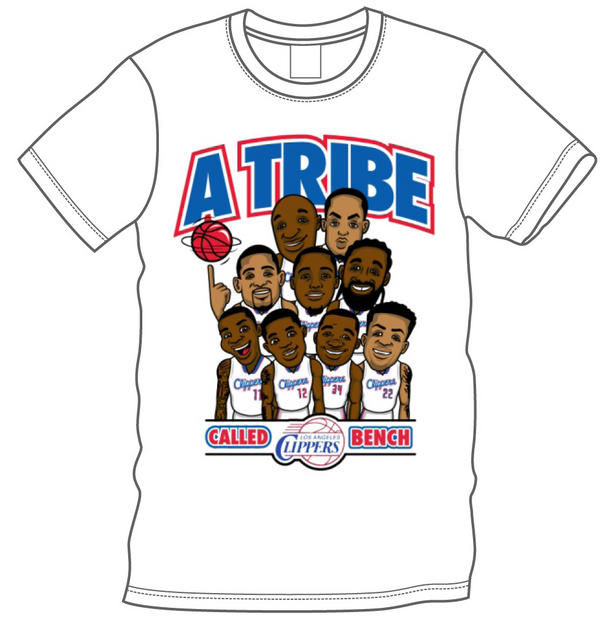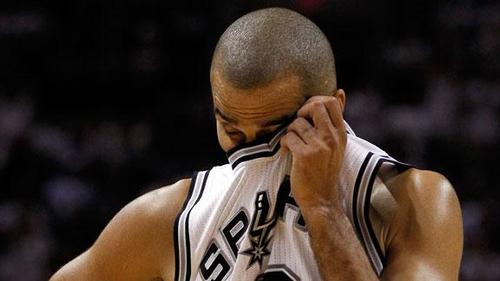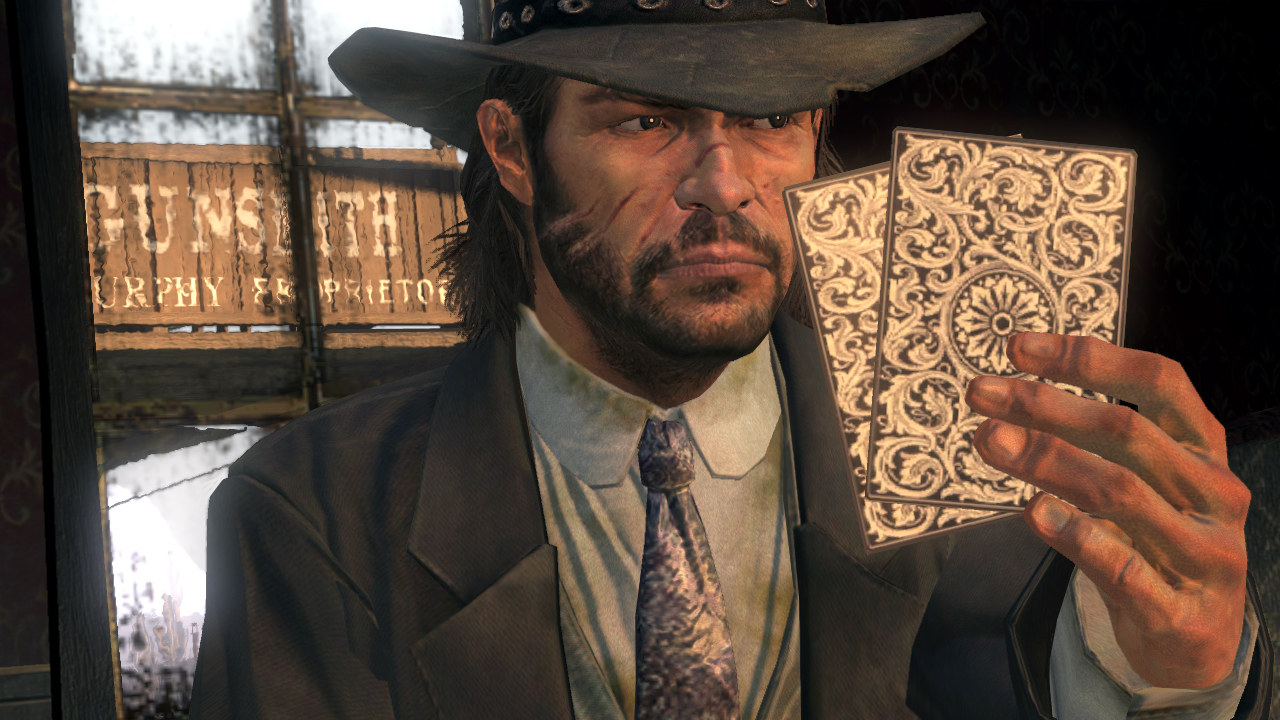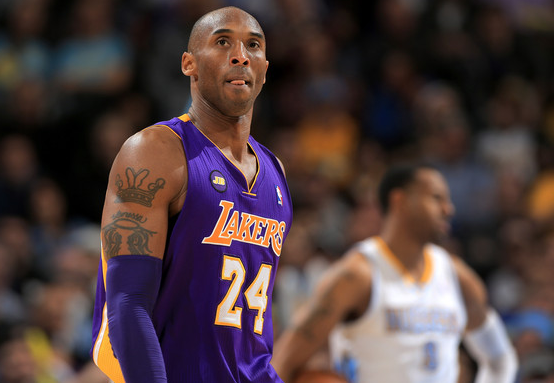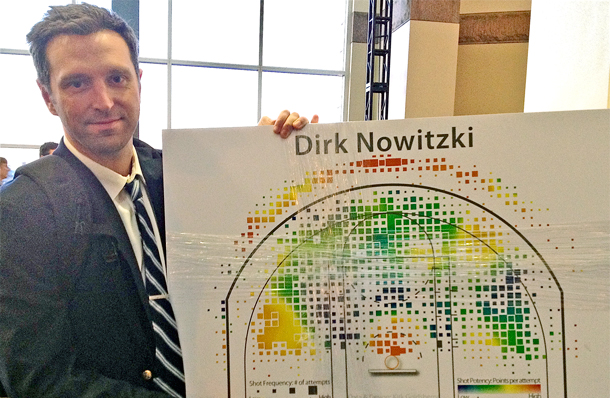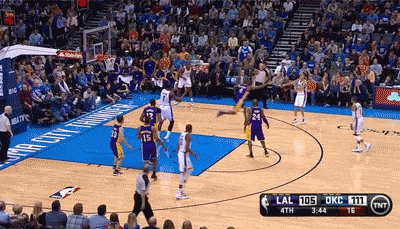The Outlet 3.13: Streakin' Ain't Easy (also: #TheReturn of Alex Dewey)
Posted on Fri 22 March 2013 in The Outlet by Aaron McGuire
Remember how we had that one series, a long time ago, where we'd entreat our writers to scribe short vignettes on the previous night's games? We've consistently discovered there's no way for us to do that every night, but with the capsules done and Aaron back in the saddle as a more active managing editor, we're hoping that we can bring the feature back as a weekly Wednesday post. Sometimes Thursday, like today. As always, the vignettes may not always be tactful, tacit, or terse -- they'll always be under a thousand words, though, and generally attempt to work through a question, an observation, or a feeling. Today's short pieces are as follows.
- DEN vs PHI: Streakin' Ain't Easy (for ESPN by Aaron McGuire)
- SAS vs GSW: Still Confusing After All These Years (by Alex Dewey)
Read on after the jump.
• • •

__OKC vs DEN: Nuggets of Redemption
___Aaron McGuire_
ED. NOTE: Originally posted with the March 21st edition of ESPN's Daily Dime. Reprinted for reader convenience.
Since a Jan. 1 upset of the Los Angeles Lakers at Staples Center, the Philadelphia 76ers have suffered an 0-14 drought on the road. The luckless lottery hopefuls were coming off of a late-breaking back-to-back (a 29-point thrashing at the hands of the Los Angeles Clippers, one must remember) and heading into an arena where the home team had won 15 of its last 15. The Denver Nuggets have averaged 111 points per game during that home streak, a stark contrast to Philadelphia's 88 points per game during their current road losing streak.
All this is to say that the world had a pretty good idea of what to expect in last night's late-night battle between the Nuggets and the Sixers: an annihilation. Oddsmakers tabbed Denver as a 14-point favorite, DESPITE missing Wilson Chandler and Ty Lawson with injuries. The game seemed destined to be a blowout where a clearly superior team runs wild on a down-on-their-luck lottery squad with nothing left to play for. Reasonable logic, although it misses one important fact.
Talent gaps are talent gaps, and oftentimes, no amount of extra heart and hustle is going to make up for that. But the spirit of an NBA underdog manifests itself in a certain curious way when winter turns to spring and lottery position firms up.
Every once in a while, for whatever reason, a lottery team doesn't simply lie on the mat and tap out. It'll show a fire it can't tap into on a regular basis. It'll come out roaring, throw the first punch, and thoroughly eviscerate a team that shouldn't be letting it in the game at all. In this case, it wasn't just "whatever reason." The reason was simple.
NBA teams, tanking or not, love ending streaks. There's nothing quite like cracking the perceived invulnerability of a team on a long winning streak. The press starts talking about their championship pedigree, its players start believing their own hype, game previews become little more than their streaking statistics and lofty praises. Fans start looking ahead and checking wins off on the calendar. "Oh, look, we're playing the three worst teams in our division. We're DEFINITELY getting at least three more wins in the streak."
Expectations. Glory. Complacency. It sets in rather quickly. And it changes the game. Suddenly, it isn't just about a bad team versus a good team. It's about an underdog proving it belongs. It's about a lesser team upending the expectations and throwing conventional wisdom under a bus. It's about the flaws of the contender, not the flaws of the lesser lights. The game becomes more akin to a March Madness upset than a garden variety NBA blowout.
The Nuggets -- due to a furious late burst and a well-timed breakout night for journeyman Corey Brewer -- don't have to suffer the ignominy of losing the streak to a team that they should've beaten. But make no mistake. Win or not, Thursday wasn't their night. As the buzzer sounded to the whoops and hollers of a Denver crowd, a visible sigh of relief passed across Nuggets coach George Karl's face. Nuggets play-by-play announcer Chris Marlowe summed it up best as the players left the court: "Ladies and gentlemen, you just saw the biggest theft since the crown jewels were stolen in the 18th century."
No kidding. Philadelphia spent much of the night lording over the Nuggets, thoroughly outplaying its hosts in an exceedingly strange turnaround. They rebounded better, they scored inside better, they moved the ball better. And they deserve all the credit in the world for it -- they fought the good fight, and they put a tangible fear into the hearts of the better team. They played swarming, trapping defense and kept Denver out of their comfort zone all night long. Heck, they managed to outscore the Nuggets in the paint. That hasn't happened since mid-February!
Philadelphia's valiant effort, even in defeat, reminded everyone watching of one of the world's most sacred truths -- probability isn't inevitability. Simply having a high chance of hitting the flush doesn't mean you will. Someday, a No. 1 seed will fall to a No. 16 seed. The Miami Heat have had to come back from the dead against teams they should've destroyed numerous times over the course of their incredible streak. Truth be told, every team on every great streak does. Adversity doesn't have to come from an obvious place; it can come from the most unexpected pasties on the schedule.
Philadelphia's effort was in vain -- the streak goes on.
But just ask the Nuggets: It sure isn't easy to win 14 straight games.
• • •
SAS vs GSW: Still Confusing After All These YearsAlex Dewey
Hey, guys! I'm here, I'm a seer, but don't get used to it.
Or, alternatively: get used to me posting more!
Or, alternatively: wait, maybe I'll be too busy for that, don't hold me to it!
Whatever. Que sera sera. What will be, will be~. (Ed. Note: Don't drink on a work night, Dewey.) Ahem. Anyway, for the first time in a while I sat down to "watch" the "games." Let me tell you personally, friends: I was happy that the Spurs won against the Warriors. I was astonished by how sprightly Tim Duncan looks. That's a cliche, but that's the point: he seems to keep getting better. No, really! Athletically he's not in the same class as any of the NBA's younger lights, but I was struck with the thought that the way he moved in his brilliant-on-both-ends 4th quarter almost evoked LeBron or Durant offensively.
... OK, Aaron, stop laughing. Yes. That's a stretch, and perhaps a slightly-younger Kevin Garnett is a far better comparison, but I just want to properly illustrate my shock. It was just ridiculously shocking to have Tim "I-sometimes-joke-about-being-a-point-guard" Duncan take the ball at the top of the key on quite a few possessions, even making the odd cut away from the post, not just to clear out space but to manage the geometry of a possession. No, Duncan isn't playing as a small, but Tim somehow reaches even deeper into his seemingly endless bag of veteran tricks.
One of the things that's overplayed when it comes to wily, hyper-skilled vets like Andre Miller and Tim Duncan is the tiresome "Still Characteristic After All These Years" trope. Sure, it's nice to see Duncan hit that 19-footer again. But when I see that, I'm feeling nostalgia for a greater past. That's not joy. Nostalgia's a mild form of depression, isn't that what they say? For joy and mirth, I much prefer the more refreshing strategy employed by the old-man game players: adaptation. By occasionally doing something completely bold and different than they've ever done but after-the-fact analogous to their existing skillset, these players show the bare bones of competitiveness that got them this far. If Andre Miller is Zach Lowe's Professor, then his course is the graduate-level Fundamentals of Fundamentals. It's that one class, you know the drill -- it's a little abstract but it's really cool because the professor has been there before a thousand times but never looks bored because the professor has a love of learning and there is always more to learn and also he's always high on something and sometimes he's roller-skating but that's OK because it's a judgment free zone also he teaches you to write enormous monstrosities of run-on sentences too it's very neat I think.
Ahem.
Yes, the course is an easy A, because you just have to show up and tune in. Still, you only get what you put in when it comes to Andre Miller and Tim Duncan, and you'd best get what you can while they're still there. Until tonight, I'd never seen Tim hop over a defender's arms while receiving the ball on a cut quite like he did in the late first quarter. It wasn't because he was jumping high, but because he was jumping true, with excellent footwork and raising his knees. Before tonight I don't think I'd seen Tim curl around defenders quite like that. I rarely see Tim as quite that active a facilitator, or even (at least these days) as quite that mobile a rim defender. Duncan dominated David Lee and Andrew Bogut defensively and neither seemed to be having anything close to a terrible game. Perhaps this is a case of not having seen the Spurs enough recently or simply of not having seen basketball much, period_._ But it was pretty neat. Duncan tried everything, and some of it actually worked.
Other observations from the caw of the lion-bird: Curry is known as a great, amazing, wow-did-he-just? shooter, but there's something even more gasp-inducing about his inevitable high release shot in traffic. I'd describe it thusly: Matt Bonner can hit threes. Stephen Curry can hit an invisible rim atop the Concorde flying the opposite direction while Curry himself is tuck-and-rolling out of a burning train going over a collapsing bridge. If you meet the Duncan in the lane, you have to kill Tim, and the only way to do that head-on against Duncan's gangly outstretched arms and timing is with floaters having nearly-vertical starting angles. And Curry can do it. He can do a swift hop straight-up and heighten the full-extension floater release at the last split-second in a consistently surprising way.
Curry does all of this marvelous work in a way that suggests consistency and the competitive intelligence to get to the line and to the rim when opponents respect his shot too much and to shoot when they respect his floater too much. I don't know where he rates out among points in the league but, in my ignorance, I still have to note that I rarely see a bad game from Curry; far more often I see an indifferent and stagnant Warriors offense, which he as point guard obviously bears some responsibility for. He's smart and he's got a potentially-historical-level jump shot, but I also get the sense that he doesn't have the speed or handle to really break a good defense. Let's be honest, though: talking about Curry's limitations only happens when we're trying to take a force of nature into a meat grinder and spit out a ranking. We have to have an opinion. My opinion is that you'd have to try in order to dislike watching Stephen Curry play. He got game.
In six, blessed minutes, Richard Jefferson did all the things he'd always been criticized for not doing on the Spurs - for playing tough, physical defense, for crashing the boards, for making the right pass with utter confidence. And in six, blessed minutes, one had to feel compassion. Because none of it worked, even remotely. Despite getting the ball in isolation in the post with a soft double, Jefferson decided to drive baseline. Turnover. Jefferson later made an athletic drive to the hoop, elbowing Manu in the ribs along the way. Charging. Then Manu got a three immediately, and on another occasion Manu embarrassed RJ with a great hand-off right in front of RJ and two other Warriors. In six, blessed minutes, we may have seen the last gasp of Richard Jefferson. I sometimes find RJ funny, conceiving of elaborate narratives that capitalize directly on the humor of Jefferson. And indeed, throughout his short first-half tenure I laughed constantly and riotously. Such fan favorites amuse us greatly. Part of sports and all that. And it occurs to me that those of us with a comedic disposition will remember our old clowns and comedians and their jokes more vividly and movingly than our leaders and heroes and their noble proclamations. Tim Duncan painted one of his latter-day masterpieces last night and I wonder (as I laugh aloud) if I'll remember it more than I'll remember RJ's caricature. His circular, faded "RJ" tattoo now with blocked, school-art-project lettering standing as large as the sun in a riotous, amusing defeat.
• • •
In case it hasn't been exceedingly obvious, Gothic Ginobili has been working on a bit of a skeleton crew lately. Our good man Dewey's started a new job, and BOTH Dewey and myself are in the process of moving. Not sure how many posts per week we'll be putting out in the week ahead, but we'll try to push forward a few more objects for your eager consumption than we have over this last few weeks. We still love you, readers! Even if we're both moving large boxes and disdainfully chugging down sports drinks!
See you next week.

